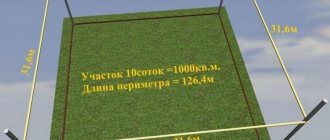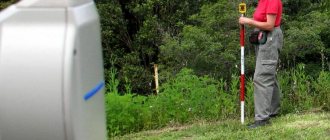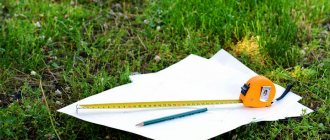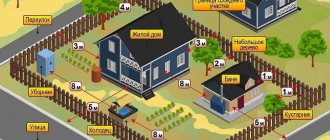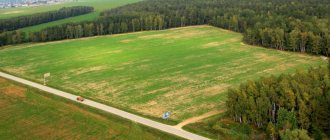What is a hundred square meters of land?
What is 1 hectare?
How many meters of land do you mean? Hectare (ha) is a unit of area measurement adopted 100 years ago, equal to 10,000 square meters. Before the revolution of 1917, another measure, now forgotten, was used to determine the area of agricultural land - the tithe. It was approximately equal to a hectare. Along with the tithe, other units of measurement also became a thing of the past: verst (1.06 km), fathom (2.13 m), arshin (0.71 m), vershok (0.045 m). One hundred square meters is both a lot and a little. For example, on 100 square meters it is theoretically possible to build a 2-storey house with an attic with a total area of more than 200 square meters, but in reality the construction of such a house will require 2-3 acres. If you have an empty plot of 6 acres, it is reasonable to build one or two houses on it with a total area of up to 300 sq.m. and on 20 acres #8212 you can build anything you want.
Decoration elements
How many square meters in a hectare, meters
A finished, thoughtful and cozy look of a suburban area is given by various decorations, which in landscape design are usually called small architectural forms.
This role may include:
- picturesque artificial reservoirs, for example, a stream, grotto, pond or waterfall;
- sculptures or various decorative figures made of stone, wood or trimmed shrubs;
- arches, terraces, pergolas and other elements of vertical gardening;
- swings or openwork benches;
- rock gardens, alpine slides, rockeries, and other plant compositions.
Did you know? One of the main symbols of Paris - the Eiffel Tower - is also a type of landscape decor. Interestingly, this structure was erected in 1889 as a temporary structure, and many Parisians, including such masters of the pen as Alexandre Dumas Jr. and Guy de Maupassant, considered it ugly and spoiling the appearance of the city.
Details
Square Meter Conversion
How many acres, square meters, kilometers and acres are in one hectare of land?
meters, acres, ares, hectares: meaning, table. how to calculate how many hectares are in one hundredth or one square meter, are: converting hundredths into hectares Help! One hectare contains a square with a side of one hundred meters. If the side size of the plot is 100 m, its area will be one hectare, otherwise 10,000 m2.
To find out the size of a land plot, expressed in hectares, you need to have a little data. To do this, you need to know the values of the length and width of the territory.
Calculation steps:
1.to calculate the area, multiply the width with the length.
2. when receiving a figure of over 10,000 m2, this means that the area value will be over 1 hectare.
3. If you need a more accurate result, expressed in hectares, the value in hectares should be divided by ten thousand.
Attention! There is an online calculator to calculate units of measurement. If there is no Internet, you will have to do the calculations yourself
Here you will need knowledge of how to correctly translate values:
If there is no Internet, you will have to do the calculations yourself. Here you will need knowledge of how to correctly translate values:
-in 1 hectare - 10,000 m2
-in 1 hundred square meters there is 1 ar, or 100 m2
-in 1 hectare there are 100 acres, or 100a
Conversion of acres
The measure of measurement originates from the number 100. One hundred square meters represents 100 m2, or 1 a.
Ares, as a unit of measurement, are not included in the SI. By multiplying the length and width of a square with a side of ten meters, you get an area of land equal to 1 are.
If a plot of land is bought or sold for a summer residence or for building a house, then the land is measured in hundreds. This term is used between people in conversations; it is not used in documents.
Convert hectares to hectares
One hectare contains one hundred acres. How to calculate area in acres. There are two methods.
1. the area in acres should be divided by one hundred to obtain the value in hectares.
2. you should multiply the area in acres by 0.01.
Example: The area of the plot is eight hectares. This means that 8 times 100 equals eight hundred acres. Or you are given a plot of land with an area of 2 thousand acres, you should divide this figure by 100, you get 20. So 20 hectares is the area of this plot.
Square kilometers, their application
One hectare has 10,000 m2. In the Russian Federation, not only these measures are used to measure area. The most common are macaws or hundreds. They are used in specific cases.
In other words, it is a square with a side equal to 1 thousand meters. And one km2 is equal to 1,000,000 square meters. This unit is used if you need to determine the area of a city, region, region, continent, or planet. For example, planet Earth has an area of 510,072 thousand km2.
Attention! 1 square kilometer is equal to one hundred hectares, otherwise one hectare is equal to only 0.01 of km2
House on 15 acres
You need to pay attention to whether the area is uprooted or not, since if uprooting of trees is required, this will require monetary costs, and sometimes not small ones. The depth of soil freezing is not such an important point that you should pay attention to when purchasing a plot, but you need to know it for your area, since the depth of the foundation, for example a strip foundation, depends on it. Visually assess the differences in heights in the area; if they are significant, leveling them will also require costs or an increase in the cost of the foundation, if it is the foundation that is used to level, for example, piles on screw piles. Be sure to study the soil (soil) on it before purchasing a plot, since rocky, peaty, quicksand, and to a lesser extent clayey ones can create problems and increase the cost of the house as a whole by an order of magnitude. The choice of foundation directly depends on the type of soil, for example, soils closer to rock completely exclude the installation of screw piles. Pay attention to the presence of a reservoir near the site, as there is always a high groundwater level and flooding is possible in the spring season
For this purpose, by the way, it is recommended to view such areas in the spring.
Pay attention to the presence of a reservoir near the site, as there is always a high groundwater level and flooding is possible in the spring season. For this purpose, by the way, it is recommended to view such areas in the spring.
- Give preference to areas with standard rectangular shapes, since in a narrow area it is difficult to plan everything correctly.
- An important point will be the possibility of connecting to electricity (the presence of a pole on the site or nearby) since electricity can be supplied to areas of new cutting for more than one year.
- The location of the site in the direction of the prevailing winds and cardinal directions is also an important point for many
Exploring the area
Analysis of the natural landscape and other features of the territory is the first stage of planning. You need to study the general characteristics of the site, which include:
- degree of soil moisture and its composition;
- terrain, presence of ditches, hills, slope of the plot;
- wind direction, illumination of different parts of the site;
- location of cardinal directions.
The soil can be sandy, clayey, fertile. If it is not saturated with useful substances, then it is not recommended to plant a large garden on the territory. But if a garden or flower beds are a must, then you will have to enrich the soil, for example, add black soil.
If the depth of groundwater is less than two meters, then a drainage system must be installed on the site. On-site water sources, such as ponds or streams, are usually used to provide recreational areas.
You need to know the slope of the ground or elevation changes in order to correctly choose the location of the house, the entrance area and the reservoir, if it is provided for by the project. This will prevent contamination of the area, as well as destruction of the foundation. The best place for this is high areas.
You can determine the illumination of zones by marking the border of the shadow with strokes at different times - 8.00, 12.00 and 19.00. The most sunlit areas will remain unshaded, and double or single shading will indicate partially illuminated areas.
Determining the prevailing wind direction on the site most of the time will help to correctly determine the location for installing a barbecue or placing a bathhouse. To prevent smoke from penetrating into living spaces, these elements should not be located on the leeward side. If the area allocated for a recreation area is blown through by winds, it can be protected using a hedge, high fence or other method.
Determining the cardinal directions is necessary for the correct planting of plants and the location of certain objects. The entrance zone should be located in the south or south-east, and the northern areas should be used for planting trees. They will hide the area from the road and neighboring plots, and also create shade. And in the east, fruit trees and vegetables grow well.
Basic planning solutions
- these are diagrams of the most successful location of the house and the most popular areas (baths, recreation areas, gazebos, children's playgrounds, etc.) from the point of view of the cardinal directions.
Layout of a plot of 12 acres of rectangular shape
The most successful configuration that will allow you to make maximum use of the usable area. A plot of 12 acres is filled based on the requirements of the owners and the characteristics of the landscape. The living area is placed on a hill, and the main windows must face west or east. Parking is available in the front area.
Design of a plot with a vegetable gardenSource www.pinterest.com
The recreation area is not visible from the entrance sector, it is removed from the house, neighbors and playground. Gazebos are removed 3 m from the cottage and guest buildings. A space of 12 acres will be equipped with:
- room (terrace) for feasts;
- area for games;
- barbecue
The children's area should be clearly visible both from the cottage and from the recreation sector. A swing, a sandbox and a slide are appropriate on the territory; additionally, there are horizontal bars and a trampoline. If there is a swimming pool nearby, then be sure to restrict access for the younger generation.
For a rectangular plot, outbuildings are not located near the house. It is more convenient to store gardening tools near the vegetable garden. Enclosures for animals and birds should not be built near a water source. Street toilets should not be closer than 20 m from housing, and cesspools and compost pits should be installed 7 m from buildings.
Site layout optionSource yurlkink.ru
On a plot of 12 acres, an important element will be a vegetable garden, sometimes combined with a garden. The zone can occupy either the majority of the territory or the standard 10-15%. A sector measuring 4x8 m is located a meter from the fence, and communications for irrigation are thought out. Tall plants should not block low ones, and the entire area should be well lit.
Plot with a house, bathhouse and greenhousesSource vsaunu777.ru
Territory zoning
If we talk about the design of a country house plot of 12 acres, its planning should begin with zoning. That is, you need a general plan of the top view, taking into account the slopes, sides and location of the fence - sketches.
Layout of the site with a children's playground in the middle, a separate area for adults, a garage combined with a utility block and a house in the back of the site
Layout of the site with a residential building and a separate garage on the front line, a recreation area in the central part, a utility room and a bathhouse in the far corners of the site
Then you can detail the project:
- Accurately draw to scale the location and shape of each object.
- To do this, they usually first do independent work, then invite a specialist to correct fundamentally important details and make professional adjustments.
- Complying with building and fire regulations is not difficult if you do not plan to build a large number of buildings. But, most importantly, the distance from the border of the site to the house should not be less than three meters.
The layout of a plot of 12 acres is a scheme, the options are usually more tailored if the owners know in advance approximately what they want. If you completely entrust this to professionals, individual inconvenience and embarrassment may subsequently arise.
A 3D project allows you to clearly see the future appearance of the site and make adjustments if necessary
Related video: do-it-yourself corrugated fence
Calculating the material for the fence is not a difficult task - just calculate the perimeter of the site. This alone will be enough to estimate how much material will be needed. For more accurate calculations, it is recommended to use the formulas and examples described above.
The craze for installing beautiful fences in Russia is dictated not only by fashion trends. With a competent approach to the process, fences can be installed on plots of 6, 8, 10, 12, 15 or 20 acres for a very reasonable amount.
And if a high-quality product is available to the majority of consumers, then its fate is determined - it will become popular.
The information in this article will help you understand the principles of calculations and production of fencing for urban and suburban areas. Having understood how much fencing is needed for 8 acres or another standard area of land, you can choose and install fencing at the best price, saving, as they say, wisely.
Huge potential
Today, a plot of 30 acres is a large plot on which you can build all the necessary structures for everyday life, beautifully decorate the estate, lay out a garden and vegetable garden, organize convenient access roads, and arrange a space for relaxation.
To implement all this, you need to develop a clear plan. It will allow you to clearly see and understand where and what zone will be located. Everyone has their own ideas about this. Some people need a spacious private workshop or a playground for children, others like to grow flowers. On a plot of 30 acres, it is not difficult to find a place to plant a beautiful spruce to create a family alley. It can accommodate a full-fledged tennis court and barbecue area.
Therefore, it is so important at the first stage to sit down and make a list of objects that you would like to see on your site. And then examine the area, study the relief, soil composition, features of the local climate, and understand what is needed to implement your own project.
Project plan for a plot of 30 acres
Units of land area measurement
The International System of Units (SI) is the most used system of units in the world, both in everyday life and in science and technology. SI is now accepted as the primary system of units by most countries in the world and is almost always used in engineering, even in countries where traditional units are used in everyday life.
- kilogram (kg, kg) - unit of mass
- meter (m, m) - unit of length
- second (s, s) - unit of time
- ampere (A, A) - unit of electric current
- mole (mol, mol) - unit of amount of substance
- candela (cd, cd) - unit of luminous intensity
- Kelvin (K, K) is 1/273.16 part of the thermodynamic temperature of the triple point of water:
- degree Celsius (°C) is a widely used unit of measurement of temperature, used in SI along with kelvin
- conversion to degrees Celsius:
House on 15 acres
When selecting a site, you must take into account whether it is upland or lowland. At all times, priority was given to areas on high ground. If the site is in a lowland, it will constantly be flooded after heavy rains and snowy winters, and even its artificial raising (filling) does not always correct the situation and is economically costly. This affects the cost of the site itself.
- Give preference to areas with standard rectangular shapes, since in a narrow area it is difficult to plan everything correctly.
- An important point will be the possibility of connecting to electricity (the presence of a pole on the site or nearby) since electricity can be supplied to areas of new cutting for more than one year.
- The location of the site in the direction of the prevailing winds and cardinal directions is also an important point for many
Site layout depending on size
Depending on how many acres the dacha plot occupies, the location of the buildings should be designed.
If your plot is large, from 12 to 15 acres, then this is conducive to a serious project on which you will have to work hard.
According to the standard plan, everything can be built here, even large objects, for example, the house here will be simply huge, with a summer terrace and spacious parking.
When developing a plan for the development of your site yourself, take into account all the nuances regarding the construction and placement of summer cottages. Use a clear work plan and follow the advice of experienced craftsmen.
Development of a project for a country plot
Dacha construction differs from ordinary home ownership in that it is mainly designed for maintaining a vegetable garden, gardening is carried out to a minimum extent, a house for seasonal residence and outbuildings for housekeeping are built on it.
Features of zoning allotment for a dacha:
- In the north there are outbuildings, a toilet and a summer shower or bathhouse, a summer kitchen and a garage.
- In the south there is a vegetable garden, the central entrance to the house.
- In the east there is a sports zone and a recreation area.
- To the west is a garage.
- Paths must be durable and connect all outbuildings and areas.
- Parking should be located in front of the house from the central entrance.
Photo of designing a summer cottage:
Table of area in GA, Meters
The simplest question is how many m2 are there in 1 hectare, or in other words, how many square meters are there in 1 hectare? The answer has been known since school lessons; similar problems were encountered in middle school, but with age, many have simply forgotten the basic rules of counting, and find it difficult to quickly convert square meters into hectares. It is for such purposes that a simple table is presented, in which you just need to select the initial values of your own land allotment. The basic indicator for identifying the area is the ratio of hectares in m2: 1 = 10,000, which follows from the very size of the hectare with square geometry, 100 by 100 meters. Simple mathematics, based on which it is easy to find out how much 4 hectares is how much m2, or how much 50 hectares is, if we are talking about large territories, for example, on farms.
You can complicate the problem, 30 km2 is how many hectares, this also occurs when the owner of the land specializes in growing grain crops, or has a herd of cows numbering in the hundreds, and for summer grazing it is necessary to have huge meadows. Therefore, not only the conversion from hectares to m2 is relevant, but also other calculations in relation to a square kilometer, hundred square meters or even an acre - the latter is by no means exotic, and still appears!
What is weaving?
Traditionally in Russia, land plots were measured in dessiatines. After the revolution of 1917, a new unit of measurement was introduced - ap. Ap is a square of 10 by 10 meters and is equal to 100 m2.
Read also: Making a bright terry flower from leather
The new value made it easier to calculate the area - a section of territory was determined by the number of squares included in it, measuring 10x10 meters. Over time, among the people, the word “ap” was replaced by the more familiar and understandable word “hundred”. If you are asked: “One hundredth is how many square meters?”, or “One hundredth of land is how much?”, feel free to answer: “1 hundredth is 1 ap or 100 square meters.” This means that the answer to the question: “10 acres is a plot of 100 by 100 meters?” will be: “10 acres is a plot of 100 by 100 meters.”
How many meters is this measure length?
Knowing how many meters a hundred square meters of land contains, you should begin calculations on a certain territory or local area:
- Along the edges of a certain area of the ground, 4 pegs are driven in, for each corner.
- Using a tape measure, measurements are taken on two sides of different sizes.
- Knowing this data, the area is calculated. For example, one side is 12, and the other is 10. In this case, S (area) = a (length) * b (width). It turns out that the area is 120 square meters.
- After this, you should find out how many acres a similar plot contains. For this, the resulting number is 120 square meters. m divided by 100. It turns out 1.2.
If the plot of land is more than 100 acres, then it is more expedient to use a unit of measurement such as a hectare. One hundred square meters is not so small, but to build a house there must be at least 3 of them.
Since Soviet times, a tradition has come to allocate 6 acres of land to families. This measure came into use after the food crisis occurred. At the same time, government structures believed that 5 acres are required for growing crops, and 1 for the construction of a small building.
Main nuances when drawing up a site plan
10 acres is how many meters long and wide.
First, you need to mark the location of the residential building on the plan. It is believed that the best location for it is the northern part of the territory. At this stage, you need to decide where the windows and patio will face.
Ideally, the terrace will be located near the southern wall of the house. Such accommodation will allow you to have lunch and even dinner outdoors until the month of October.
On the plan diagram of an area of 15 acres, the area for planting green spaces (trees, bushes and shrubs) must be marked, since when placing garden paths it is necessary to take into account the types and characteristics of the plants being planted. The diagram must indicate their exact number and names.
How many square meters in one hundred square meters - Answer
Construction
Weaving is a measure of area that is used by all summer residents. Many people often ask the question - how many acres is this or that plot? Let's find out - How many square meters are there?
It is noteworthy that measurement in hundred square meters is not common in every state. In particular, in the UK they use acres and square yards to measure the area of land.
As for the distance, they use feet and miles, and not the meters that are used in our country for calculations.
The origin of the word “weave” and how many meters are there?
As for our country, land plots are measured in acres, as well as in hectares.
In general, one hundred square meters is equal to one hundred square meters, i.e. a square of land having a length and width of ten meters, that is, 10 meters * 10 meters = 100 m2 = 1 weave.
Initially, instead of the hundred, the measure of length was used, which is also equal to one hundred square meters. This is where the name “hectare” comes from, i.e. one hundred ares. However, now this designation is practically not used, and measuring the area in acres has become more traditional.
This measure of measurement is now used in many documents where we are talking about calculating the area of land, but previously this name was in use only at the household level.
Sotka became a derivative of the numeral “hundred”, i.e. one hundred square meters that we talked about earlier. This is where the spread of the common people's "weave" came from.
Calculation examples - How many square meters in one hundred square meters
We have given an answer to the question: how many square meters are in a hundred square meters, so the next step is to give an example of an approximate calculation of the area.
So, let’s describe the measurement of a land plot step by step:
- To begin with, you need to drive four stakes around the entire perimeter of the site, i.e. at four corners to form borders.
- Then we arm ourselves with a tape measure to measure the length and width of the area. It is enough to measure only two sides, because... the other two will be the same size. Let's say that our length is 38 meters and width is 24 meters. We write down this data on paper.
- Let's remember our geometry lessons by calculating the area of a rectangle, i.e. S = a (length)* b (width). Total, S = 38 * 24 = 912 square meters.
- Now you need to find out how many acres are in this plot of land. To do this, the resulting area (912 m2) must be divided by 100. We got 9.12 acres.
Second example:
- We measure the land plot in the same way as before.
- The resulting values were: length = 44 meters, width = 21 meters.
- Using the same formula we calculate: S = a * b, i.e. 44 * 21 = 924 square meters.
- We divide the resulting value by 100. In total, we get 9.24 acres - this is exactly the size of our second plot.
It is worth noting that if the land plot is more than one hundred acres, then for convenience the unit of measurement is used - a hectare, which is equal to these hundred acres.
Interesting facts (How many square meters in one hundred square meters)
In general, one hundred square meters is not so much if you look at such a plot with your own eyes. Of course, theoretically, it is possible to build a 2-story house with a small extension on one hundred square meters, but as practice shows, it is better to build on a plot of about three hundred square meters, no less.
In Soviet times, the expression “six hundred” was in use, which arose approximately in the period from 1960 to 1970.
Initially, land plots were given to rural residents for their personal farming, but with the advent of the food crisis, the situation changed a little.
This was done for practical reasons, because in a similar way they planned to solve the problem of food shortages in cities, by growing various vegetables, berries and fruits on the plots.
Based on the logic of the leaders of those times, in order to feed a family of four, a certain amount of fruits and berries was required:
- apples - 65 kg per year;
- pears - 5 kg per year;
- plum - 3 kg per year;
- cherry - 6 kg per year;
- currants - 3 kg per year;
- gooseberries - 2 kg per year; raspberries - 4 kg per year;
- strawberries - 6 kg per year.
Sotka was already used at a completely official level, so this word, initially positioned as a colloquial word, can long ago be considered recognized in the business sphere.
Technology for calculating materials for fences
There are also no big difficulties here and even, according to experts, you can do without drawings. It is enough to remember a few important nuances:
- the main support pillars are installed in each corner + along the edges of the gate and wicket openings;
- the number of auxiliary supports depends on the estimated width of the covering material;
- The height of the fence directly affects its cost.
As an example, let’s try to find out how many meters of fence per 10 acres will be needed, provided that the profiled sheet marked C8 is chosen as the flooring, and the support posts are made from a 60x60 mm profile pipe. Let's say we have a plot of 30 x 33 with a total area of 990 m² (almost 10 acres). We divide the length of each side of the site by the width of the profiled sheet (for example, 1.15 m) - we get 107 pieces.
If the supports are brick, the number of metal profiles will decrease due to the thickness of the pillars. We will consider the gate and wicket as a separate side using solid sheets of metal covering. If the number turns out to be fractional, then we round it up so as not to get a hole in the fence.
We calculate the footage of the log based on the length of the profile and the design quantity (3 m each). Simple math also works here. We divide the total footage by 3, rounding up and multiply by the number of joists used in the fence (usually 2 or 3 rows).
In total, the calculation showed that for the simplest fence made of corrugated sheets and metal supports, we will need 107 sheets of corrugated steel, 246 meters of thin pipe for making logs. The number of main and auxiliary supports, provided they are spaced every 2.5 meters, is 49.
Next, we place a table that gives the basic calculations for making fences in. Here you can clearly determine how much a fence of 10 acres costs for a house within the city or a fence of 6.8 acres (a standard summer cottage).
Calculation for a plot of 10 acres with a perimeter of 130 m
Normative base
So, the owner of the site has an impressive area, which is a blank slate. You need to place all the necessary buildings and decorative objects on it. When planning them, it is necessary to rely not only on the basics of landscape design, which will provide the territory with a beautiful view, but also on legislation. Unfortunately, it will not work to build based solely on your aesthetic taste. Otherwise, the owner faces large fines and even demands for demolition. The regulatory framework includes a set of documents regulating the construction of commercial and residential buildings. The owner of the site needs to familiarize himself with three fundamental rules and regulations:
- Development and planning;
- Fire safety basics;
- Code of sanitary standards.
Fire safety
Fire standards are expressed in regulations regarding the minimum permissible distance between buildings made of different materials. When designing, focus on the following numbers:
- Wooden buildings (baths, sheds) are located in such a way that a distance of at least 15 m is maintained between them;
- Houses made of stone, concrete and brick, which are non-combustible materials, are built from their analogues at a distance of 6 m. The minimum distance between them and structures supplemented with wooden floors will be 2 m greater. The distance to frame-type buildings made of wood is increased by another 2 m;
- Buildings made of non-combustible materials with wooden floors are installed at a distance of 8 m from similar houses. For structures made of wood, the distance is increased by 2 m.
In addition to these standards, it is worth considering additional rules:
- A distance of at least 3 m is maintained from the dacha plot and the border with neighbors;
- For buildings for household needs, the distance is reduced by 2 m;
- There must be at least 5 m from any type of building to the “red” street line.
To protect yourself from violations, it is necessary to outline a conditional internal contour on the plan, within which it is permissible to place structures.
Sanitary standards
In addition to fire standards, it is also necessary to comply with sanitary standards. They are consulted not only to avoid fines, but also for their own safety. Infectious diseases often arise due to human negligence. If a pipeline is not planned, then you need to worry about digging a well or drilling a well. The former will “feed” from groundwater that lies beneath the surface of the soil, while the latter will draw resources from deeper layers. Clean water will help ensure compliance with simple standards. Cesspools or compost pits, structures for keeping poultry and livestock must be placed at a distance of at least 12 m from the well or well.
In addition, a residential building must be located at a certain distance from buildings of various types:
- Country toilets on the street - at least 13 m;
- “Food” trash cans, landfills and compost heaps - from 9 m;
- Summer shower or bathhouse - at least 5 m;
- Other buildings that are intended for household needs - from 13 m or more.
There are also rules regarding planting trees and plants:
- Flower beds and bushes less than 0.5 m tall are planted at a distance of at least 1 m from the fence;
- Tall trees - from 4 m and more. So that over time their crown does not cover the street or neighbors’ garden plots;
- Trees of medium height - from 2-3 m;
It is recommended to adapt the garden and vegetable garden to the features of the landscape in such a way as to emphasize its strengths and hide its shortcomings.
Garden
It is better to locate the gardening area in the most illuminated part. If you dream of a good harvest of strawberries and tomatoes, plant a vegetable garden near the southern border. It should be located as close to the well as possible, so as not to extend the irrigation system throughout the entire territory. Consider how the house and outbuildings are located. The shed with the equipment should be as close as possible to the garden, but at the same time it should not cast a shadow on the beds.
It is recommended to place a vegetable garden behind a residential building, and a garden and flower beds - in front of the facade
But here it is important not to plant trees in front of the windows, because in 10-15 years they will deprive the house of light. Decorate your local area with bright flowers and low shrubs
